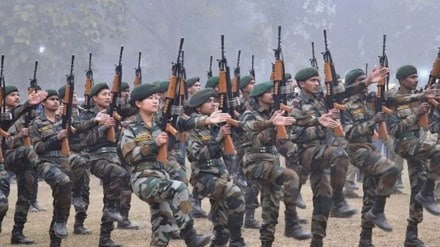The defence ministry appears to be walking the talk on celebrating 2025 as the Year of Reforms. A day after the Cabinet Committee on Security gave its final nod for the purchase of 307 indigenously designed and developed artillery guns at a cost of Rs 7,000 crore, the Defence Acquisition Council (DAC) also approved the guidelines for reducing the procurement timelines at various stages of the capital acquisition process to make it faster, more effective, and efficient. The new guidelines are expected to reduce the timelines of the procurement process by 10-15%. The DAC, chaired by defence minister Rajnath Singh, also accorded Acceptance of Necessity, the first step of the procurement process, for eight proposals worth over Rs 54,000 crore. These include procurement of 1,350 horsepower engines to upgrade the Army’s T-90 tanks to enhance their battlefield mobility, especially in high-altitude areas.
The push for indigenous production aligns with Prime Minister Narendra Modi’s Aatmanirbhar Bharat initiative, which aims to reduce dependence on foreign defence suppliers and boost domestic manufacturing. This is an absolute necessity considering that the defence sector stands to feast on orders adding up to $138 billion over a decade from FY24. Defence aerospace orders will account for $50 billion, and missiles and artillery $21 billion. According to the Stockholm International Peace Research Institute, a leading conflict think tank, India was the fourth largest military spender in the world in 2023: It spent $836 billion, up 4.2% over 2022. India was also the largest arms importer in 2023, with 36% coming from Russia (against over 50% a decade ago), followed by the US and France, which together accounted for 46%.
India’s push towards self-reliance in defence equipment for the armed forces has yielded some results. Production has grown by double digits over the last decade, more than doubling from Rs 46,429 crore in FY15. The pace of growth has picked up further post-pandemic as the country targets the goal of Rs 3 lakh crore of defence production by 2029. Defence exports reached Rs 21,083 crore in FY24, rising 33% from the previous year, and have expanded nearly 10 times since FY15 when they were just Rs 1,900 crore. But the worry is that private sector participation is yet to pick up steam, with private defence firms’ share in production remaining unchanged between 19 and 21%, according to data from the defence ministry dashboard.
India lacks tech in many areas of defence products, mainly engines and key critical parts, and it will take time to develop those capabilities. Experts say domestic industry will take years to realise big orders and revenues as it’s a rigorous process and involves extensive testing to ensure quality and technological capabilities are of global standards. The introduction of defence procurement processes often encounters various challenges that can impact the efficiency, effectiveness, and transparency of the acquisition. Safeguarding India’s security in the current geopolitical landscape necessitates the commitment of equipping the armed forces with modern, state-of-the-art weapons. The government should strive to make strategic investments in cutting-edge weaponry that not only enhances deterrence capabilities but also ensures a robust offensive posture. To achieve self-reliance, encouraging indigenous research and development becomes imperative, thereby encouraging innovation and reducing dependence on external sources. A forward-looking and comprehensive modernisation strategy will not only fortify national security but also position India as a resilient and technologically advanced force on the global stage.
